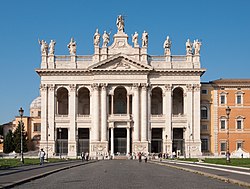User:Latium/Sandbox6: Difference between revisions
Jump to navigation
Jump to search
No edit summary |
|||
| (12 intermediate revisions by the same user not shown) | |||
| Line 1: | Line 1: | ||
{{Region_icon_Ajax}} | {{Region_icon_Ajax}} | ||
{{Infobox Christian denomination | |||
== | | icon = Emblem_of_the_Papacy_SE.svg | ||
| icon_width = 25px | |||
| icon_alt = | |||
| name = Imperial Church | |||
| native_name = [[Standard Latin language|Latin]]: Ecclesia Imperialis | |||
| native_name_lang = | |||
== | | image = San_Giovanni_in_Laterano_-_Rome.jpg | ||
| imagewidth = 250px | |||
| alt = | |||
| caption = [[Archbasilica of Saint John Lateran]] in [[Castellum]], the ''[[wikipedia:cathedra|cathedra]]'' seat of the [[Pope (Ajax)|Pope]] as [[#Governance|Imperial Primate]]. | |||
| abbreviation = | |||
[[ | | type = [[wikipedia:National polity|National polity]] | ||
=== | | main_classification = [[Fabrian Catholic Church|Catholic]] | ||
| orientation = [[Fabrian Catholic Church#Latin Church|Latin]] | |||
| scripture = [[wikipedia:Bible|Bible]] | |||
| theology = [[wikipedia:Catholic theology|Catholic theology]] | |||
=== | | polity = [[wikipedia:Episcopal polity|Episcopal]] | ||
| governance = [[Episcopal Conference of Latium]] | |||
== | | structure = [[Aurelius Aricius]] | ||
| leader_title = [[Pope (Ajax)|Pope]] | |||
| | | leader_name = [[Pontian XI]] | ||
| | | leader_title1 = [[Imperial Episcopal Conference (Latium)|Praetor]] | ||
| | | leader_name1 = [[Aurelius Messala]] | ||
| | | leader_title2 = [[#Governance|Imperial Primate]] | ||
| | | leader_name2 = Pontian XI | ||
| | | leader_title3 = [[Apostolic Imperial Nuncio|Apostolic Nuncio]] | ||
| leader_name3 = [[TBD]] | |||
| fellowships_type = | |||
| fellowships = | |||
| fellowships_type1 = | |||
| fellowships1 = | |||
| division_type = | |||
| division = | |||
| division_type1 = | |||
| division1 = | |||
| division_type2 = | |||
| division2 = | |||
| division_type3 = | |||
| division3 = | |||
| associations = | |||
| area = [[Latium]] | |||
| language = [[Standard Latin language|Latin]] | |||
| headquarters = [[Archbasilica of Saint John Lateran]] | |||
| origin_link = | |||
| founder = [[wikipedia:Apostles in the New Testament|Apostles]] [[wikipedia:Saint Peter|Peter]] and [[wikipedia:Saint Paul|Paul]] | |||
| founded_date = 1st century | |||
| founded_place = [[Castellum]], [[Latium|Latin Empire]] | |||
| separated_from = | |||
| parent = | |||
| merger = | |||
| absorbed = | |||
| separations = | |||
| merged_into = | |||
| defunct = | |||
| congregations_type = | |||
| congregations = | |||
| members = <!-- or |number_of_followers = -->78,000,000 | |||
| ministers_type = | |||
| ministers = | |||
| missionaries = | |||
| churches = | |||
| hospitals = | |||
| nursing_homes = | |||
| aid = | |||
| primary_schools = | |||
| secondary_schools = | |||
| tax_status = | |||
| tertiary = | |||
| other_names = | |||
| publications = | |||
| website = | |||
| slogan = | |||
| logo = | |||
| footnotes = | |||
}} | }} | ||
The '''Imperial Church''', or '''Imperial Catholic Church''', is part of the [[Fabrian Catholic Church]] in communion with the [[Pope (Ajax)|Pope]], who concurrently serves as the Imperial Primate and [[Bishop of Alba]]. The Imperial Church also includes diocese located in parts of [[Gelonia]] and [[Sasora]]. Since 2023, there are 290 diocese in the Imperial Church. | |||
The Pope, as leader of the Imperial Church, resides in the [[Fabria]] district of [[Castellum]], which has been a major center for [[Sarpetic religions|Sarpeticism]] since the establishment of the Church. As a result [[Castellum]] is regarded as the home of the Catholic Church. Many apostolic relics are located in Castellum, particularly Fabria, which serves as the administrative center of the both the Imperial Church and the worldwide church. | |||
==History== | |||
[[category:Latin's user page and sandboxes]] | [[category:Latin's user page and sandboxes]] | ||
Latest revision as of 19:18, 31 December 2023
Imperial Church | |
|---|---|
| Latin: Ecclesia Imperialis | |
 | |
| Type | National polity |
| Classification | Catholic |
| Orientation | Latin |
| Scripture | Bible |
| Theology | Catholic theology |
| Polity | Episcopal |
| Governance | Episcopal Conference of Latium |
| Structure | Aurelius Aricius |
| Pope | Pontian XI |
| Praetor | Aurelius Messala |
| Imperial Primate | Pontian XI |
| Apostolic Nuncio | TBD |
| Region | Latium |
| Language | Latin |
| Headquarters | Archbasilica of Saint John Lateran |
| Founder | Apostles Peter and Paul |
| Origin | 1st century Castellum, Latin Empire |
| Members | 78,000,000 |
The Imperial Church, or Imperial Catholic Church, is part of the Fabrian Catholic Church in communion with the Pope, who concurrently serves as the Imperial Primate and Bishop of Alba. The Imperial Church also includes diocese located in parts of Gelonia and Sasora. Since 2023, there are 290 diocese in the Imperial Church.
The Pope, as leader of the Imperial Church, resides in the Fabria district of Castellum, which has been a major center for Sarpeticism since the establishment of the Church. As a result Castellum is regarded as the home of the Catholic Church. Many apostolic relics are located in Castellum, particularly Fabria, which serves as the administrative center of the both the Imperial Church and the worldwide church.